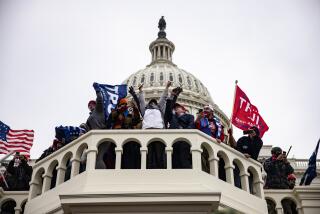The Real Story Left Untold
- Share via
SANTA CRUZ — About every 10 days, a New York Times review found, a mass, random, public shooting occurs in the United States. Each is a tragedy with flesh-and-blood victims and grieving survivors tormented that they missed warning signs of the violence. The shooter usually is a middle-class or affluent white male rejected or persecuted by peers, co-workers, students, wife, girlfriend, employer--everyone. Most often, he is middle-age; occasionally, a young adult or teenager.
Teenagers who avenge affronts by spraying schoolmates with bullets have more in common with “dissed white male” adult rage killers than with other teens. Authorities and reporters who portray school shootings as “youth” or “school” phenomena are missing this big picture.
For it isn’t school shootings themselves that motivate society’s horror. As reaffirmed by the anguished reactions to last week’s gun violence at Santana High School in the San Diego suburb of Santee, the only rage killings that win sustained national attention are school shootings with white victims. There was scant nationwide news or commentary about recent gun murders of black and Latino students in gang or personal disputes at schools in Baltimore, Oxnard, Lynwood and Pomona, among others.
Nor do prominent authorities agonize over children dying in rage shootings by adult killers. No expert reaction and only passing media attention ensued when a middle-age gunman murdered four teenagers in a Texas church, an Ohio man shot three teenage girls and his Bible study teacher to death, and an Atlanta man massacred three teens, a child and three adults. Rather, the media, politicians and experts reserve their most horrified outrage for killings in which white students are shot by another student at school, no matter how many months or years apart these occur. But what makes this rare brand of America’s many public shootings more horrifying than the ones ignored?
It’s not because such school killings are common. Of the 150,000 Americans murdered by gunfire in the last decade, perhaps 150 were killed in or around a school, and only a fraction were white youths. If the U.S.’s overall murder rate was as low as that in high schools, America would be safer from homicide than Sweden.
It’s not because school killings are unprecedented. Many (including august experts) claim school shootings never used to happen, but they most certainly did. In 1979, Brenda Spencer, 16, shot and killed two children and injured nine at a San Diego elementary school. In 1974, a small-town New York honor student opened fire at his high school, killing three and wounding nine. Orange County’s only recorded high-school shooting, a wounding at Anaheim’s Loara High, occurred in the 1980s, and its deadliest college incident (seven murdered at Cal State Fullerton) in 1976. So completely have we forgotten past school shootings that the 10th anniversary of California’s worst--the 1989 Stockton school massacre (five children dead, 29 wounded--passed unnoticed. The child victims were the wrong color (Cambodian and Vietnamese) and the white gunman too old (26) to rekindle outrage.
The fixation on shootings of and by white students is not because they portend social breakdown. In fact, they’re stark anomalies in a dramatically less murderous younger generation. The latest (1999) state crime figures report murder by white youths at a record low, 65% below its 1970s rate (homicides by black, Latino and Asian youths also plunged). Nor are killers getting younger. FBI Uniform Crime Reports show elementary-school students much less likely to murder today than in the 1960s and 1970s. Nor are schools meaner. The only long-term national survey, “Monitoring the Future,” finds both white and black youths less menaced by school violence now than a quarter century ago.
The reasons that apocalyptic import is ascribed to white-student killings are not edifying. Typically, commentators dramatize suburbs such as Santee and Littleton, Colo., site of Columbine High’s 1999 massacre, as paradise lost, where residents “didn’t think violence could happen.” Yet, violence happens in suburbs. Santee law enforcement logged 264 domestic violence calls and 154 violent felonies, including homicide, in 1999. However, the myth of the suburban enclave generates a media paradox: White-student shootings become big news because they are extremely rare even as they are hyped as imminent threats to every pastoral community.
Furthermore, unlike adult or minority-youth killings, white-student shootings allow commentators to dismiss larger, disturbing complexities such as poverty, racism and adult violence to invoke simplistic “culture war” distractions: media images, video games, music, the menace of “alienated” youth. “Lost Boys” author James Garbarino blames school shootings on “the dark side of adolescent culture” whose “seriously troubled” followers reinforce their alienation through Internet connections. The surgeon general’s “youth violence” report declares healthy students hold “an intolerant attitude toward deviance” and “commitment to traditional values and norms,” an unsettlingly close description of bullies. Students are urged to report the slightest maledictions by strange peers, even though police, psychiatrists and counselors closely acquainted with real school shooters have proved incapable of predicting when they will strike.
There’s a major difference between official response to overt threats (as in the De Anza College student arrested in January after police found a cache of arms in his room along with a plan to attack his school) versus sweeping school edicts banning purses and backpacks, harshly punishing trivial expressions and portraying “reject” kids who react against bullying by “normal” students, teachers, coaches and administrators as potential maniacs. “Students already at risk, already suffering, have become suspects, linked in various thoughtless ways to mass murder and--consequently--more alienated than before,” writes “Geeks” author Jon Katz, summarizing thousands of student e-mails. Informing on friends’ ambiguous disgruntlements is not easy for youths taught by experience to doubt the fairness and judgment of authorities. Reporters and Santana’s administration, as happened in prior shootings, berated and punished not the popular students known to have harassed the shooter, but the shooters’ friends.
Understanding “why” school shootings occur requires junking popular cliches in favor of confronting uncomfortable questions. Why, for example, does the U.S. suffer vastly outsize gun violence compared with peer Western nations? Europe, Japan, Canada and Australia share our violent media and “dark” Internet cultures yet have gun fatalities measured in the tens or hundreds rather than thousands. European-style gun restrictions remain unattainable here as long as tens of millions of Americans, many terrorized by repeated media declarations that random violence threatens everyone, believe they need guns.
Second, how long will U.S. leaders, media and violence experts, unlike those in safer nations, continue to sensationalize infrequent murders by youths and evade addressing far more common, deadlier mass shootings by grown-ups? This is a crucial failing, because the rate of teenage gun killings in any area can be predicted with 80% accuracy simply from the rate of adult gun killings. This powerful correlation leaves no realistic way to “get guns away from kids” without getting guns away from grown-ups.
Finally, why do Americans relentlessly characterize youths by their worst fraction? Indulging demeaning stereotypes to stigmatize all youth as dangerously “at risk,” imposing media censorship, ostracizing nonconformists and abrogating adolescent rights only alienates more young people from adults. Ultimately, is it troubled “rejects” or bullying hierarchies that most provoke violence?
More to Read
Sign up for Essential California
The most important California stories and recommendations in your inbox every morning.
You may occasionally receive promotional content from the Los Angeles Times.










